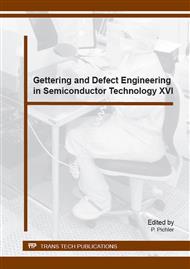p.252
p.258
p.264
p.271
p.279
p.285
p.290
p.296
p.302
Effect of Nitrogen-Doping on the Properties of Radiation Defect Centers in FZ Silicon
Abstract:
High-resolution photoinduced transient spectroscopy (HRPITS) has been applied to determining the properties and concentrations of radiation defect centers formed in FZ silicon single crystals subjected to doping with phosphorus in neutron transmutation processes. The studies were performed immediately after the neutron irradiation on the samples with the resistivity of the order of 105 Ωcm. The preset target resistivity was around 2000 Ωcm. The N-doping effect on the material radiation damage has been demonstrated. It is shown that in the N-enriched material, the radiation defect centers with activation energies of 81, 125, 160, 185, and 390 meV are not observed and the concentrations of the defect centers with activation energies of 46, 84, 133, 140, 265, 300, 380, 460, and 546 meV are significantly lower than those in the N-free material. We also show that the majority of defect centers produced by the irradiation of FZ silicon with fast neutrons are also observed after neutron transmutation doping.
Info:
Periodical:
Pages:
279-284
Citation:
Online since:
October 2015
Price:
Сopyright:
© 2016 Trans Tech Publications Ltd. All Rights Reserved
Share:
Citation:


